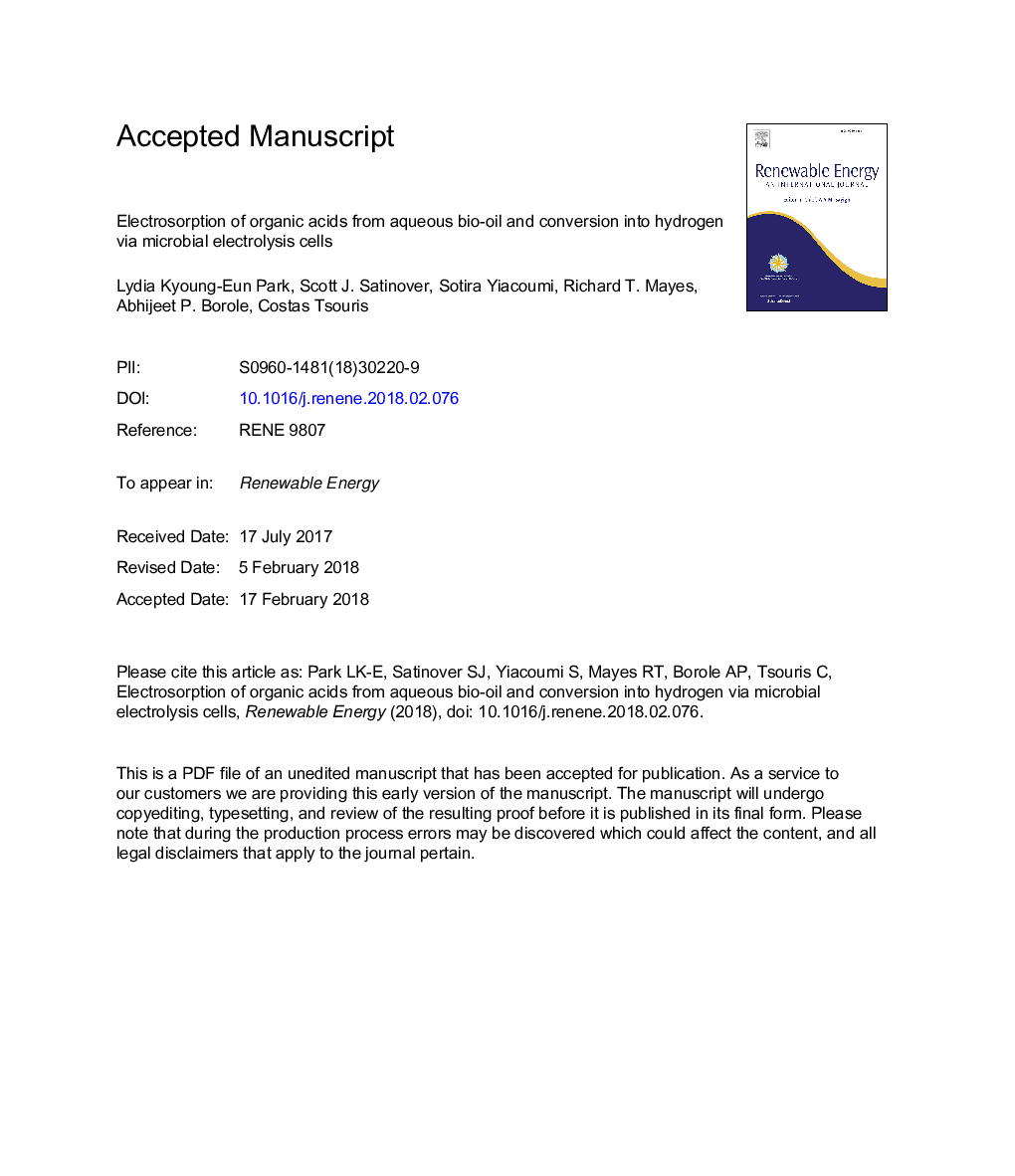| کد مقاله | کد نشریه | سال انتشار | مقاله انگلیسی | نسخه تمام متن |
|---|---|---|---|---|
| 6764284 | 1431579 | 2018 | 39 صفحه PDF | دانلود رایگان |
عنوان انگلیسی مقاله ISI
Electrosorption of organic acids from aqueous bio-oil and conversion into hydrogen via microbial electrolysis cells
ترجمه فارسی عنوان
الکتروشوراسیون اسیدهای ارگانیک از روغن زیستی آبی و تبدیل به هیدروژن از طریق سلول های الکترولیز میکروبی
دانلود مقاله + سفارش ترجمه
دانلود مقاله ISI انگلیسی
رایگان برای ایرانیان
کلمات کلیدی
ASTMGC-FIDTANCDIMECEDLNBOBJHNaOHGLDNISTpH neutralizationBrunauer–Emmet–TellerCapacitive deionization - deionization ظرفیتElectrosorption - الکترولسورسMicrobial electrolysis - الکترولیز میکروبیBarrett–Joyner–Halenda - بارت جوینر هالنداCoulombic efficiency - بازده کولومیکchemical oxygen demand - تقاضای اکسیژن شیمیاییAmerican society for testing and materials - جامعه آمریکایی برای آزمایش و موادElectrical Double Layer - دو لایه برقBio-oil - روغن زیستیMicrobial electrolysis cell - سلول الکترولیز میکروبیBET - شرطTotal Acid Number - شماره اسید کلBio-oil aqueous phase - فاز آب بیولوژیکی روغنNational Institute of Standards and Technology - موسسه ی ملی استانداردها و تکنولوژیPyrolysis oil - نفت پیرولیزsodium hydroxide - هیدروکسید سدیمCod - کادوhigh-performance liquid chromatography - کروماتوگرافی مایعی کاراHPLC - کروماتوگرافی مایعی کارا
موضوعات مرتبط
مهندسی و علوم پایه
مهندسی انرژی
انرژی های تجدید پذیر، توسعه پایدار و محیط زیست
چکیده انگلیسی
Neutralization of the bio-oil pH has been shown to generate a neutralized bio-oil aqueous phase (NBOAP) that includes most of the acidic components and a neutralized bio-oil organic phase (NBOOP) that includes hydrophobic organics, such as phenols. NBOOP can be used for fuel production, while NBOAP can be fed to microbial electrolysis cells (MECs) for hydrogen production. After pH neutralization, some organic acidic components remain in NBOOP. This work is focused on capturing acidic compounds from NBOOP through water extraction and electrosorption, and demonstrating hydrogen production via MECs. Capacitive deionization (CDI) is proven effective in capturing ions from NBOOP-contacted water and NBOAP via electrosorption. Captured acidic compounds enable the MEC application to effectively produce renewable hydrogen. Chemical oxygen demand (COD) removal of 49.2%, 61.5%, and 60.8% for 2, 4, and 10â¯g/L-anode/day loading were observed, corresponding to a total COD degradation of 0.19â¯g/L, 0.79â¯g/L, and 1.3â¯g/L, respectively. A maximum hydrogen productivity of 4.3â¯L-H2/L-anode/day was obtained. Major compounds in the water phase such as fatty acids, sugar derivatives, furanic and phenolic compounds were converted to hydrogen with an efficiency of 80-90%. This approach may lead the entire biomass pyrolysis process to be an overall carbon-neutral process.
ناشر
Database: Elsevier - ScienceDirect (ساینس دایرکت)
Journal: Renewable Energy - Volume 125, September 2018, Pages 21-31
Journal: Renewable Energy - Volume 125, September 2018, Pages 21-31
نویسندگان
Lydia Kyoung-Eun Park, Scott J. Satinover, Sotira Yiacoumi, Richard T. Mayes, Abhijeet P. Borole, Costas Tsouris,
